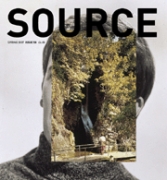A Serious Traveller
Emerson and Photography, 1885 -1895 The National Media Museum, Bradford 2007
Review by Justin Partyka
Issue 50 Spring 2007
View Contents ▸
The Old Order and The New: P. H. Emerson and Photography, 1885-1895 provides a rare opportunity to see up-close Emerson's thought provoking photographs made in East Anglia during the late nineteenth century.
The exhibition presents a general survey of Emerson's work, exploring key themes to highlight his important role in the historical development of photography. These themes include: placing Emerson's work into the context of the Victorian tourist invasion of East Anglia; his interest in forms of rural work; his quest for 'naturalism' and the acceptance of photography as fine art; the role that the Norfolk painter T. F. Goodall had as a collaborator; and Emerson's importance in the use of photogravure printing methods. Almost one hundred photographs are included and the beauty of Emerson's prints alone make the show a must-see. The deep tonal range of the platinum prints from his first book, Life and Landscape on the Norfolk Broads (1886), are especially notable and definitely deserve repeated viewings. The Clay-Mill - Plate XXI, Pictures of East Anglian Life, 1888 (Photogravure) The Royal Photographic Society Collection
The Clay-Mill - Plate XXI, Pictures of East Anglian Life, 1888 (Photogravure) The Royal Photographic Society Collection
The section on tourism reveals Emerson to be a pioneering photographer of place. Emerson considered himself a serious 'traveller' and held a great disdain for tourists, who he believed were helping to destroy the traditional ways of rural life in East Anglia. The exhibition provides the opportunity to compare Emerson's photographs with those of the East Anglian tourist photographers John Payne Jennings and Christopher Davies, whose images were used to promote the region. It is a treat to see Jennings' carbon prints which were originally hung in the train carriages of the Great Eastern Railway, but the pastoral romanticism of these coastal scenes clearly highlights their intended function as Victorian tourist propaganda. Emerson did everything he could to distance himself from the tourist photographers and establish his work in East Anglia as a serious photographic project. He lived almost permanently in the region during the years he photographed there, and mainly worked in winter when the tourists were absent. Compared to Jennings' and Davies' sentimentality, Emerson's photographs of the Broads with its reed cutters and eel catchers, show us the true character of this remote and often bleak area, revealing the close relationship between the local people and the landscape in which they live and work.
At the centre of Emerson's work lies his commitment to naturalistic photography, which the exhibition explores in the section titled, In Or Out of Focus. Emerson is contrasted with H. P. Robinson, the leading art photographer of the time. A practitioner of pictorialism, Robinson believed photographs should mimic realist painting, as shown by the comparison between his photograph Bringing Home the May (1862) and John Everett Millais' painting Spring (Apple Blossoms) (1856-59). Emerson argued the opposite, believing that to be art, photographs had to be natural: that is, unstaged, and - crucially - depicting a scene as the eye sees it, with not every feature of the photograph being in sharp focus, which he achieved through differential focusing techniques. Emerson's best images certainly show the rich visual qualities of naturalism, as evident in A Winter's Morning (1887), The Clay-Mill (1888), Cutting the Gladdon (1886), and The Lonely Fisher (1895). However, Emerson's commitment to naturalist photography is not apparent in all of the photographs on display. A Fisherman at Home (1887), Confessions (1887), The Stickleback Catcher (1887) and other images suggest that not only did Emerson set up scenes to photograph, he also often abandoned the use of differential focusing of which he was such an advocate.
Being able to see and compare so many of Emerson's images at one time provides a valuable insight into his strengths and weaknesses as a photographer. When at his best (perhaps with Goodall's help), Emerson was a master photographer of the vernacular, creating unique, timeless photographs of East Anglia's expansive desolate landscape and the rural workers who inhabited it. But a number of the pictures also clearly indicate that he was just as capable of making mediocre photographs too, relying upon the same sentimentality and pictorial composition of those photographic contemporaries he so despised.
If there is a highlight of the exhibition it is the new interpretation of Gathering Water-Lilies (1886), revealing it to be an image of a work activity - collecting lilies as bait for fish - and not simply a pastoral Broadland leisure scene as previously thought. The close similarity between Water-Lilies' companion photograph, Setting the Bow-Net (1886), and T. F. Goodall's painting of the same scene is also shown, forcing us to reconsider how many of these photographs were actually the result of a close artistic collaboration between these two men, rather than just Emerson's vision alone. A welcome addition is also the multi-media terminals featuring digitised versions of Emerson's books, allowing viewers to see how the photographs were originally accompanied by his detailed ethnographic text.
It is twenty years since a major exhibition of Emerson's photographs was held in the UK. This timely new showing of his work serves to remind us that at the heart of the best photography lies an intense commitment to a project, a dedication to developing a unique visual aesthetic, and - above all - a mastering of the photographic craft. Sadly this often seems forgotten in our technology-obsessed society, where everybody with a mobile phone has become a 'photographer,' and Photoshop can turn any photograph into a masterpiece. An hour or two spent in the company of Emerson's photographs comes as a welcome relief, and goes a long way to restore one's faith in the value of the photographic image.
Other articles on photography from the 'Documentary' category ▸






